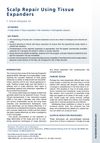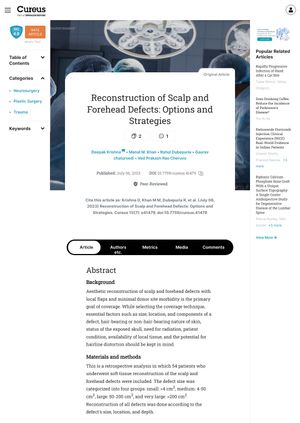TLDR Local flaps are effective for covering small to large scalp and forehead defects with good cosmetic results.
The document is a retrospective study of 54 patients who underwent reconstruction of scalp and forehead defects at the All India Institute of Medical Sciences, Bhopal, from 2016 to 2021. The study found that the most common cause of these defects was trauma (29.6%). The reconstruction aimed to achieve coverage with well-vascularized soft tissue that is cosmetically acceptable with minimal donor site morbidity. The choice of coverage technique was determined by factors such as size, location, need for radiation, and the potential for hairline distortion. Small defects were typically closed primarily, medium-sized defects were managed with different types of flaps, large defects were managed by transposition flaps, and for defects larger than 200 cm2, free tissue transfers were used. Most scalp defects could be managed with local scalp flaps with or without skin grafting at the donor site. The study concluded that local flaps could be utilized in the coverage of small to large scalp defects with a good cosmetic outcome.
 18 citations
,
March 2018 in “Archives of Plastic Surgery”
18 citations
,
March 2018 in “Archives of Plastic Surgery” The superficial temporal artery flap is a reliable method for reconstructing complex facial defects with minimal complications.
 11 citations
,
August 2013 in “Facial Plastic Surgery Clinics of North America”
11 citations
,
August 2013 in “Facial Plastic Surgery Clinics of North America” Tissue expanders effectively repair large scalp defects and restore a natural-looking scalp.
 19 citations
,
February 2008 in “Facial Plastic Surgery”
19 citations
,
February 2008 in “Facial Plastic Surgery” The article concludes that microvascular free flaps, especially the latissimus dorsi flap, are recommended for large scalp reconstructions, and hair transplantation offers high survival rates and excellent aesthetic results.
 50 citations
,
May 1999 in “Journal of Reconstructive Microsurgery”
50 citations
,
May 1999 in “Journal of Reconstructive Microsurgery” Microsurgical reconstruction effectively covers complex scalp defects but doesn't improve survival for cancer-related cases.
 19 citations
,
February 2008 in “Facial Plastic Surgery”
19 citations
,
February 2008 in “Facial Plastic Surgery” The article concludes that microvascular free flaps, especially the latissimus dorsi flap, are recommended for large scalp reconstructions, and hair transplantation offers high survival rates and excellent aesthetic results.
 January 2022 in “Plastic and Aesthetic Research”
January 2022 in “Plastic and Aesthetic Research” Choose the simplest, most fitting scalp reconstruction method for each patient's unique needs.
 1 citations
,
January 2010 in “Elsevier eBooks”
1 citations
,
January 2010 in “Elsevier eBooks” The document concludes that local flaps are effective for reconstructive surgery in the head and neck, offering good skin match and function.
 April 2024 in “Archives of Dermatological Research”
April 2024 in “Archives of Dermatological Research” The approach improves scalp surgery results by tailoring techniques to defect size and location.
 1 citations
,
November 2002 in “Neurosurgery Clinics of North America”
1 citations
,
November 2002 in “Neurosurgery Clinics of North America” The article concludes that cranial reconstruction should aim for the best aesthetic result, using various techniques tailored to individual needs and conditions.








